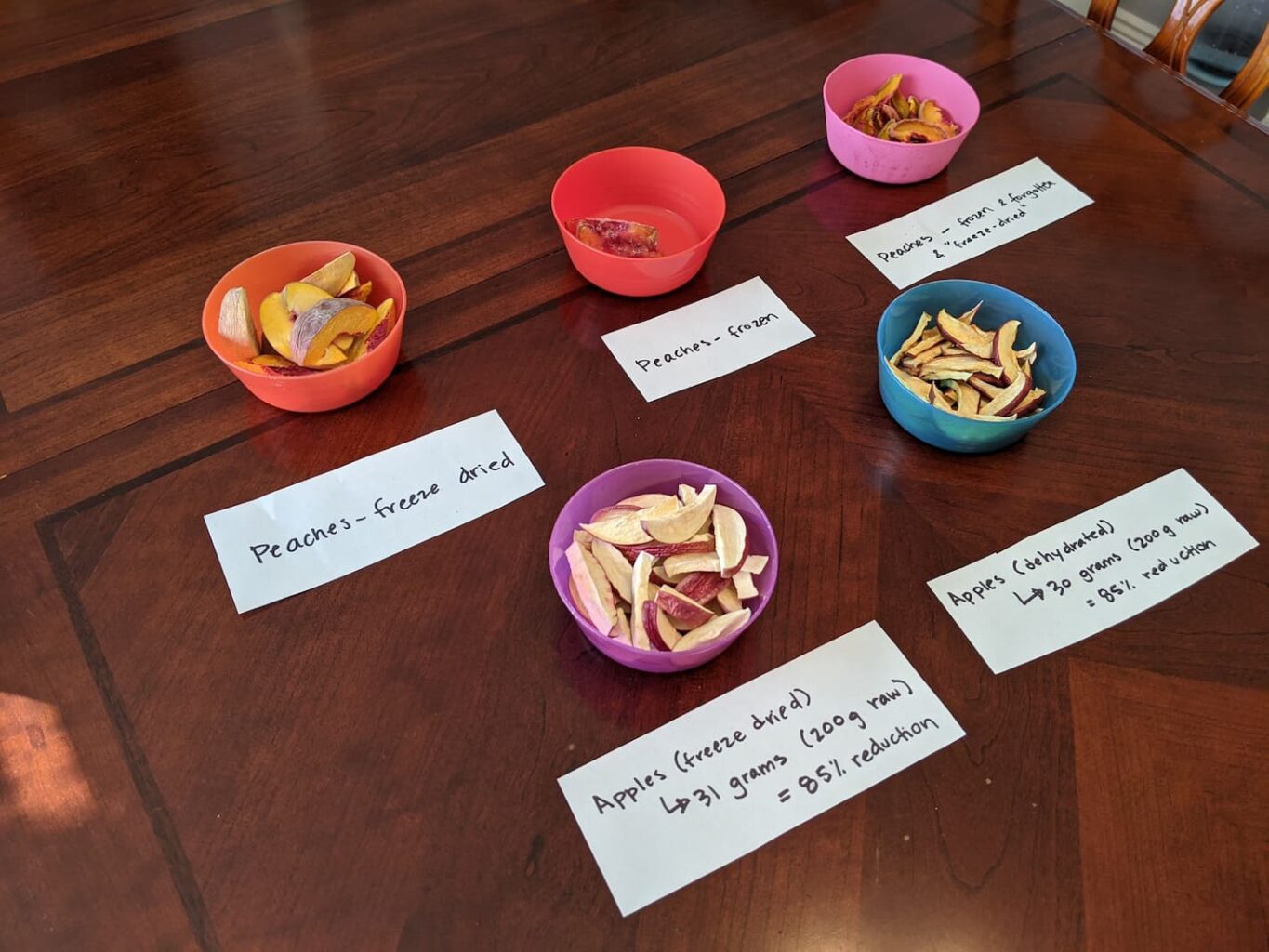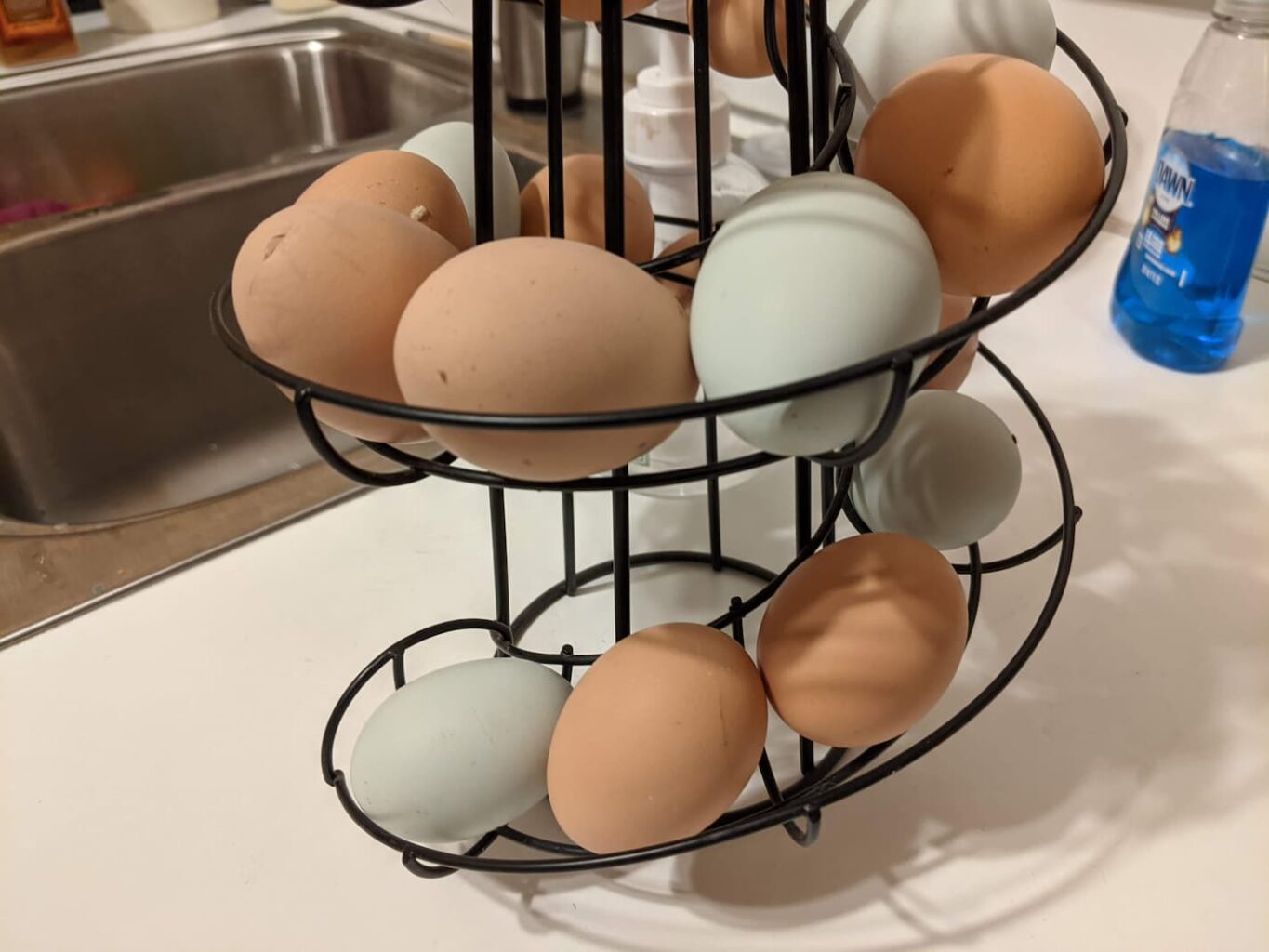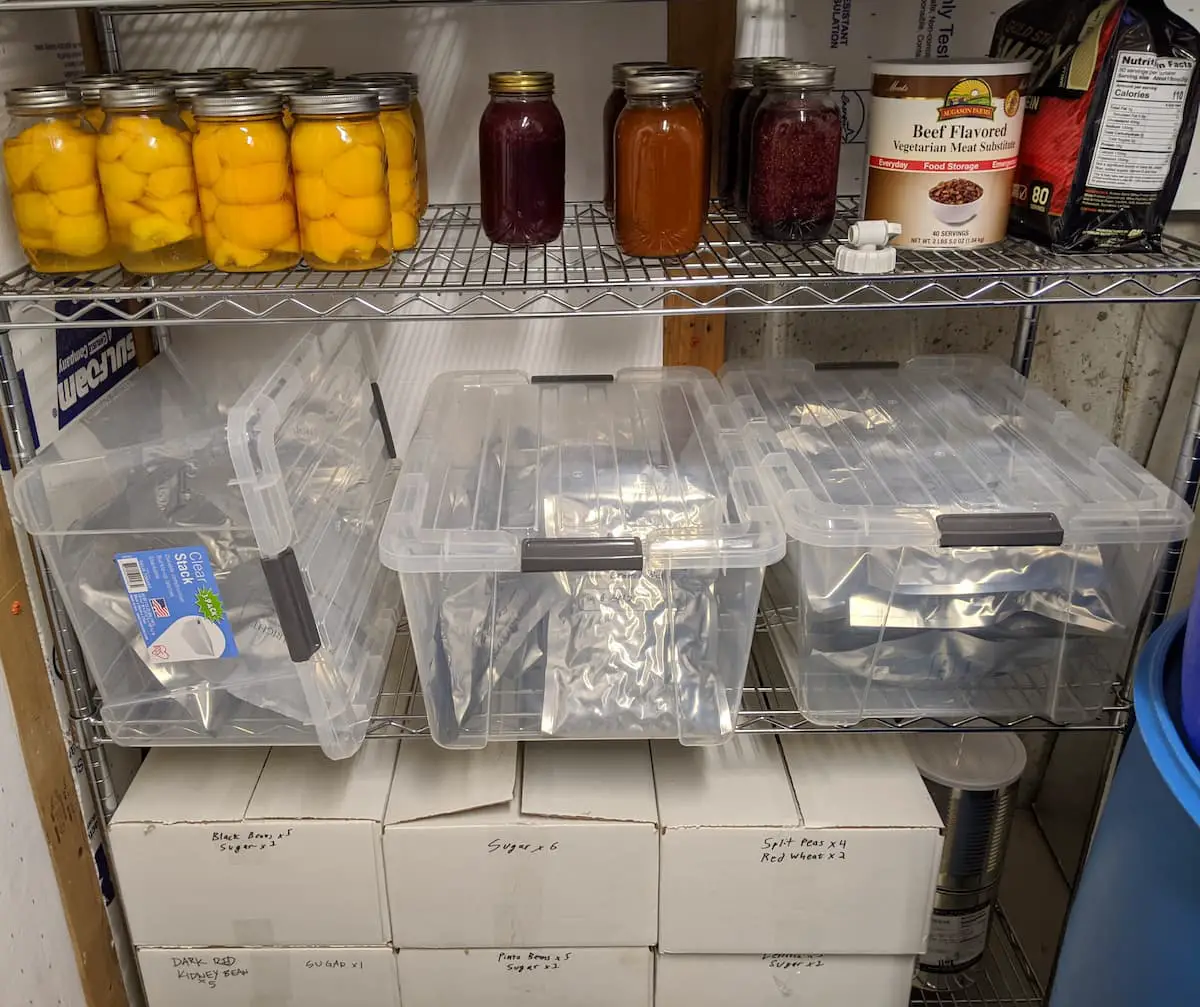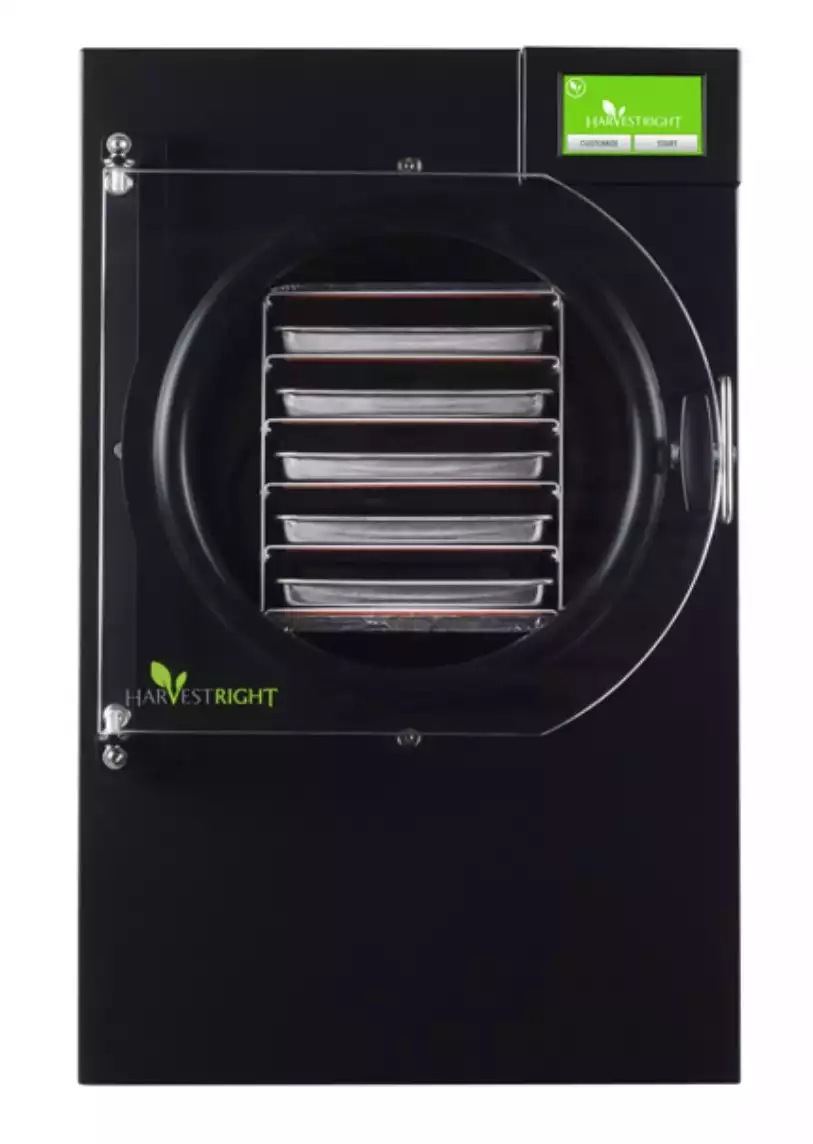Freeze-drying foods can be a lot of fun – but it’s also totally normal to wonder if what you’re hoping will freeze-dry will do so. Which foods can you freeze dry – and which won’t?
The best foods to freeze dry are foods your family will eat and enjoy. Popular foods to freeze-dry include fruits, vegetables, eggs, dairy products, grains, meat, meals, herbs, and candy and treats. Food too high in fat or sugar won’t freeze dry well, if at all.
Ready to see what works – what doesn’t – and what might work if you learn the right tricks for freeze-drying? Here’s everything I’ve learned through trial and error and research.

Best Foods to Freeze Dry at Home
The best foods to freeze-dry are those your family uses daily but that you’d like to store for longer than 3-4 months, up to 25+ years.
Here are some of the most popular foods people freeze-dry.
- Fruits
- Vegetables
- Dairy Products
- Eggs
- Meat and fish
- Meals, Soups, and Stews
- Grains and bread (and dough starters)
- Candy and treats (or desserts)
- Herbs and spice
- Other foods (condiments, pet food)
I think the best foods to freeze-dry are fruits, vegetables, eggs, and dairy products (like yogurt and sour cream). Sour cream and mushrooms only get used in small amounts or powdered form, so freeze-drying them works best for our family. My kids think freeze-dried yogurt is one of the best snacks ever.
What Foods Can You Freeze Dry?
Most foods can be freeze-dried, though foods high in fat, sugar, and alcohol or containing large bones may not freeze-dry or last as long as foods without these items.
Freeze-drying is highly versatile, and if you’ve got a home freeze-dryer, you can see what works for you!
Want to get the cheat sheet of what foods do and don’t freeze-dry in an easy-to-download PDF? HQ Insiders get the freeze-drying cheat sheet, other exclusive subscriber goodies, plus our free newsletter.
Click here to join the HQ Insiders.Foods That Don’t Freeze-Dry
In the home setting, foods high in fats, oils, alcohol, and sugar don’t freeze dry either. Bones also do not freeze dry well. Freeze-dried foods with these items will have a shorter shelf life.
- Sugar: Due to the structure and nature of sugar, it’s harder for them to freeze-dry, though it can work, especially if cut into small pieces, so there’s lots of open surface area when freeze-drying. Double-test sugary foods for moisture before storing them in mylar bags.
- Fat: Fat doesn’t freeze dry well. A high-fat content also causes freeze-dried foods to go rancid faster, so fattier freeze-dried foods have shorter shelf lives.
- Water – All the water gets removed during the freeze-drying process.
- Alcohol: Alcohol doesn’t freeze dry at all. Attempts end in huge messes. However, if a dish has a small amount of cooking alcohol, it should be okay.
- Bones: Bones don’t freeze dry. They are too hard and dense.
These foods are high in one of the above ingredients, so they don’t freeze-dry properly alone (if at all). They can often be freeze-dried as an ingredient in something else, though.
- Peanut butter
- Nutella
- Butter
- Honey
- Mayonnaise
- Nuts
Best Fruits to Freeze Dry
The best fruit to freeze-dry is whatever you enjoy most. Fruit high in water content or covered (in a peel or rind) can be harder to freeze-dry and take much longer to freeze dry. Peeling and slicing fruit can make freeze-drying significantly easier and faster.
Fruits are, by far, one of the most popular things to freeze-dry, as fruit is tasty and doesn’t lose any taste, deliciousness, or nutrition when freeze-dried.
Once the fruit has been freeze-dried, it becomes candy – only it’s the kind of candy you won’t get in trouble for eating… unless you don’t drink enough water. Then you’ll have some digestive troubles.
Freeze-drying is an excellent way to preserve fruit for long-term storage and a great way to enjoy fruits all year round.
Here are some of the fruits we’ve experimented with freeze-drying and some notes.
- Apples: Applies are best freeze-dried in slices or small pieces. They can be plain or coated with something like cinnamon or caramel.
- Bananas: Bananas are a popular freeze-dried option in slices. They can discolor easily, so you may want to pre-treat them with citric acid.
- Cherries: These must be prepped first by being pitted and halved. Delicious!
- Grapes: Freeze-dried grapes are better than candy! They freeze-dry best when halved.
- Pears: Freeze-dried pears are delicious treats.
- Melons: Some melons freeze-dry better and easier than others – but all are delicious!
- Peaches: Sliced peaches are amazing. You don’t have to blanch them – just slice, freeze-dry and enjoy. I love these on cereal – I’ll use milk or water to hydrate them, depending on how quickly I want breakfast.
Read more: Complete Guide to Freeze Dried Fruit (with pictures).
Berries for Freeze Drying
Berries are some of the best fruits to freeze dry because they retain flavor and texture. Here are some of the best berries to freeze dry.
- Blackberries: These are great for adding to shakes or eating as is.
- Raspberries: More fruit candy! I love using these in shakes or on cereal. I add extra milk to hydrate them.
- Strawberries: These freeze-dry especially well when sliced or topped. This is another personal favorite for a topping on cold (or hot) cereals with milk.
Read more: Freeze Drying Berries: How-to and FAQs Answered.
Tropical Fruits to Freeze Dry
Tropical fruits are another great option for freeze-drying. Here are some of the best tropical fruits to freeze dry.
- Avocado: It freeze-dries well but can discolor unless you treat it beforehand with lemon or some acid (citric or acetic work best).
- Citrus: Citrus, in general, can freeze dry, but it takes extra effort simply due to the sugar content and the design of the fruit and rind. Removing the rind makes freeze-drying easier, although you can also freeze-dry the rind alone.
- Mandarin oranges: An accessible citrus to freeze-dry if you do the canned ones.
- Passionfruit: Sliced fruit candy!
- Pineapple: Cut pineapple into small pieces for best freeze-drying – then enjoy!

Best Vegetables to Freeze Dry
The best vegetables to freeze-dry are those you enjoy and use most. Vegetables are generally easy to freeze-dry, although some veggies do better when shelled, cut, or sliced into smaller pieces.
When it comes to freeze-drying vegetables, not all vegetables are created equal. Some vegetables retain flavor and texture better than others during freeze-drying. Here are some of the best vegetables to freeze dry.
- Asparagus: This freeze-dries great. Just be sure to reconstitute it slowly and via humidity, or it will get super soggy.
- Broccoli: Cut up the florets into small pieces for optimal freeze-drying. Add them directly to a soup if you’re impatient like me.
- Cauliflower: Some people say it’s like keto popcorn! I prefer it in soups.
- Celery: It works best when cut into tiny bits and then powdered to add to our meals. It does better as part of a meal, like a tuna salad (made with a mayo replacement), than alone.
- Corn: Remove the corn from the cob – and those delicious pieces of corn should freeze-dry.
- Green Beans: Due to their shell, green beans must be cut up small or shelled to freeze dry and reconstitute without being a soggy mess. I think it’s better to dry them. If freeze-dried, they are great for soups or powders.
- Mushrooms: Mushrooms are one of my favorite things to freeze-dry. Slice them, freeze-dry them, and go. They are extremely versatile and can handle being reconstituted in various ways – or being turned into powder. Mushroom freeze-drying tips: How to Freeze Dry Mushrooms: 12 Tips You Can’t Miss.
- Okra: Sliced okra does best.
- Peas: Peas freeze dry fantastically – and you don’t have to do much with them.
- Peppers – Slice, dice, or chop them up. They work great! Read more: How to Freeze Dry Bell Peppers: 5 Simple Steps!
Freeze-drying vegetables is easy, and most reconstitute just fine. Each of these reconstitutes differently. Some will need to be put in a bowl of water, while others will need to be put in a humid environment and given plenty of time. Speeding those veggies’ reconstitution up will result in soggy vegetables that may have an off-putting crunch in the center.
The veggies that don’t reconstitute well can still be added to a soup, chili, or stew. Or they can be powdered and used like a powdered spice, although it’s a vegetable.
Root Vegetables for Freeze Drying
Root vegetables like carrots, potatoes, and onions are excellent choices for freeze-drying. They are hardy and can withstand freeze-drying without losing flavor or texture. Plus, they are versatile and can be used in various dishes.
- Carrots: Sliced work best, though sticks would probably work, too.
- Onions: Onions can be plain, diced, chopped, sliced, caramelized, or in a dish. Just know that the smell and flavor may affect any other food in the freeze dryer – and for several loads after.
- Potatoes: When thinly sliced, parboiled potatoes make an excellent option for homemade, freeze-dried potato chips!
- Sweet Potatoes are fantastic once freeze-dried, whether alone or added to a dish.
Leafy Greens to Freeze Dry
Leafy greens (spinach, kale, lettuce) freeze-dry well, though thinner leafy greens generally become brittle and are better to powder than bother reconstituting. Thicker leafy greens (like cabbage) do great at freeze-drying and reconstituting.
Leafy greens are packed with vitamins and nutrients and retain flavor during freeze-drying. They are worth having freeze-dried in any pantry, even as powders.
Freeze Drying Dairy and Eggs
The best dairy and egg freeze-drying options are whatever you will use, although having freeze-dried milk and eggs on hand as a staple is always a good idea.
Dairy can freeze-dry amazingly well, which is great – because it’s the only long-term storage option for dairy unless you want to get a milk cow (or goat). But by freeze-drying your dairy products, you don’t have to worry about remembering to feed and milk them.
Freeze drying is a great way to preserve dairy and egg products for long-term storage. Here are some tips for freeze-drying dairy and eggs.
Important reminder: Foods with a higher fat percentage won’t freeze-dry as well or won’t last as long as their lower-fat versions.
Dairy Products
Milk, cheese, yogurt, kefir, cream cheese, and sour cream can all be freeze-dried, though higher-fat variations won’t last as long as lower-fat varieties. It’s important to note that the texture and flavor of some dairy products may change after freeze-drying.
When freeze-drying cheese, it’s best to shred or grate it first. This will help it dry more evenly and prevent clumping. Once the cheese is freeze-dried, it can be stored in an airtight container for up to 25 years.
Butter can be freeze-dried in its solid form or melted and freeze-dried, though it does better as an ingredient in something than it does being freeze-dried on its own. Once freeze-dried, it can be stored in an airtight container for up to 10 years.
Cream cheese and sour cream can also be freeze-dried. However, they may become crumbly after freeze-drying. To prevent this, try adding a small amount of milk or cream before freeze-drying – or plan on powdering it completely.
For higher-fat dairy products, consider watering them down before freeze-drying them. This could help them freeze dry better and last longer.
Read more: How to Freeze-dry Milk (Goat, Cow, Sheep, Human, Nut).
Eggs
Eggs can also be freeze-dried and used in a variety of recipes. Raw eggs can be whisked and freeze-dried to make egg powder, which can be used in baking and cooking. Generally speaking, two tablespoons of egg powder equals one egg.
Cooked scrambled eggs can also be freeze-dried and used for camping meals. However, they cannot be used for baking unless they’re a topping.
To freeze dry eggs: crack them into a bowl and whisk them together. Pour the mixture onto a freeze-drying tray (better yet, pour them into a silicone ice cube tray on the freeze-drying tray) and freeze-dry. Once freeze-dried, the eggs can be stored in an airtight container for up to 25 years.
Overall, freeze-drying is a great way to preserve dairy and egg products for long-term storage. Just remember to take into account any changes in texture and flavor that may occur during the process.

Freeze Drying Meats and Fish
The best meats and fish to freeze-dry are low-fat cuts your family will eat and enjoy. You can freeze-dry raw or cooked meats and fish. Freeze-drying cooked meats and fish is safer than freeze-drying raw due to the risk of foodborne illness. Clean thoroughly after freeze-drying raw meat and fish.
Beef, chicken, poultry and fowl, pork, fish, game meats, ground meats and sausages, and bacon freeze-dry well. Removing as much fat as possible when freeze-drying meats is important, as it can go rancid over time and cause the meat to spoil.
To freeze-dry meats, start by cooking them thoroughly and allowing them to cool. Then slice the meat into thin strips or small pieces. Arrange the pieces on the freeze-dryer trays, ensuring they do not touch each other.
Set the freeze-dryer to the appropriate settings for the meat and let it run until completely dry. This can take anywhere from 24 to 48 hours, depending on the meat’s thickness and the freeze dryer’s power.
Once the meat is dry, store it in airtight containers, such as mason jars or vacuum-sealed bags. Freeze-dried meat can be stored for six months to 25 years, depending on the cut.
Here are some tips to keep in mind when freeze-drying meats:
- Remove as much fat as possible before freeze-drying.
- Slice the meat into thin strips or small pieces for faster and more even drying.
- Make sure the meat is thoroughly dry before storing it.
- Store the freeze-dried meat in a cool, dry place away from light and moisture.
By freeze-drying meats and fish, you can have a supply of protein-rich food that will last for years. It’s a great way to stock up on emergency food supplies or to take on camping or hiking trips.
Freeze-dried meat can last for several years if it’s stored properly. Keeping it in airtight containers in a cool, dry place is important. Once the container is opened, the meat should be consumed within a few days.
Read more: How to Freeze-Dry Meat for Safe Long-Term Storage.
Freeze Drying Whole Meals and Prepared Foods
The best meals and prepared foods to freeze-dry are those your family will enjoy and use, as well as those that are bone-free and have a low sugar and fat content to maximize shelf life. Meals that have more sugar and fat can still be great, though their shelf life will be shorter.
Freeze-drying your favorite prepared foods is a great way to extend their shelf life, preserve their flavor and nutritional value, and ensure you always have a supply of delicious meals. Meals can be freeze-dried partially or fully prepared and ready to eat.
Here are some tips and tricks for freeze-drying soups, stews, casseroles, and pasta.
Freeze Drying Soups, Broths, and Stews
When freeze-drying soups, broths, and stews, it’s important to keep in mind that the liquid content will affect the drying time and texture of the final product. To ensure the best results, follow these steps:
- Cook your soup or stew usually, but reduce the liquid content by 25% to 30%. This will help the food dry faster and prevent sogginess.
- Once the soup or stew is cooked, let it cool to room temperature.
- Pour the cooled soup or stew into a shallow, freezer-safe container or bag. Avoid deep containers, as they will take longer to freeze before freeze-drying.
- Freeze the soup or stew until solid.
- Remove the frozen soup or stew from the container or bag and place it on the freeze-drying trays.
- Freeze dry the soup or stew according to your machine’s instructions.
Freeze Drying Casseroles and Pasta
Casseroles and pasta dishes can also be freeze-dried with great success. Here are some tips to keep in mind:
- Cook your casserole or pasta dish as you normally would, but avoid using ingredients high in fat or oil, as these can turn rancid during the freeze-drying or storage process.
- Let the casserole or pasta dish cool to room temperature.
- Cut the casserole or pasta dish into small, bite-sized pieces.
- Place the pieces on the freeze-drying trays, ensuring they are not touching.
- Freeze dry the casserole or pasta dish according to your machine’s instructions.
By freeze-drying your favorite soups, stews, casseroles, and pasta dishes, you can always have a supply of delicious, nutritious meals on hand, whether preparing for an emergency or just looking to extend the shelf life of your favorite foods.
Freeze Drying Grains, Bread, and Dough Starters
The best way to store whole grains is dry in a sealed #10 can, as they’ll last decades that way. Bread, parboiled grains, and dough starters can be freeze-dried successfully and are shelf-stable, though reconstitution requires a lot of patience.
- Bread: You can freeze dry bread to make it last longer. However, freeze-dried bread won’t be as soft and fluffy as fresh bread, so it’s best used for things like croutons or bread crumbs. Reconstitute slowly and with humidity, not soaking. The bread will develop an odd texture if you go too fast when reconstituting.
- Rice and beans: Parboiled rice will do better than fully-cooked rice once freeze-dried and reconstituted.
- Sourdough starters: This is a great way to keep and store starts – and they reconstitute well enough to be viable as starts.
In my experience, it’s not worth freeze-drying whole grains. I like having some parboiled grains (especially rice) on hand, though, as it’s like having 1-minute rice.
Best Candies, Treats, and Desserts to Freeze-Dry
The best treats to freeze-dry are ones your family already likes to eat. Due to the high sugar content, most freeze-dried treats won’t keep as long (probably 5-10 years at most), but they tend to be eaten long before they go bad due to their deliciousness.
It’s easy to freeze-dry various candies and treats, and desserts. Here are some of the most popular options – along with a few important notes from my experience and research.
- Caramels: It can be tricky to freeze-dry, but it’s possible if cut into small bits.
- Cheesecake: Cut the cheesecake into small pieces to freeze-dry it. You can eat it that way or reconstitute it slowly in a humid area (like a Ziploc baggie).
- Gummy bears: My research says it works – but we haven’t tried it because we aren’t a gummy bear family.
- Ice cream: Use small scoops – and make sure you’ve got your freeze-dryer set up to go from a cold state, or it’ll melt. Once freeze-dried, it’s delicious! Pre-freeze the freeze dryer, or the ice cream will melt.
- Ice cream sandwiches: Make sure they’re cut into small pieces, or they won’t freeze-dry as well. Also, a small bite goes a long way! This is a time to pre-freeze the freeze-dryer before you insert the trays.
- Jello: Use small jello cubes for the best results.
- Marshmallows: You thought marshmallows were good before? Try freeze-drying them.
- Skittles: Yup. These are amazing once freeze-dried, though they split out of the shell.
- Chocolate: Freeze-drying chocolate can help preserve its flavor and texture. However, it’s important to note that pure chocolate (without added ingredients like nuts or caramel) is the best candidate for freeze-drying.
Best Snacks to Freeze Dry
The best snacks to freeze-dry include fruits, vegetables, cheese, yogurt, Jolly Ranchers, Skittles, ice cream, marshmallows, and grapes. Any food that can be freeze-dried can become a great snack to have on hand – and they don’t have to be reconstituted with water to be eaten.
Some of my favorite freeze-dried snacks are grapes, ice cream sandwich bites, Skittles, berries (of any kind), and peach slices.
Herbs and Spices to Freeze-Dry
The best herbs and spices to freeze-dry are homegrown and regularly used. Most spices are so fragile that they will powder after being freeze-dried.
Any spices and herbs can be freeze-dried. From there, most will work best as powders. That’s because most herbs and spices are pretty fragile – so it’s easier to powder them than stress about getting little leaves off the trays.
Fragrant herbs and spices should only be freeze-dried with foods that won’t be harmed by absorbing those fragrances (and flavors). You may want to clean the freeze-dryer unit before running another load.
For example, it was great when we freeze-dried some garlic and onion. But we also did raspberries, and they had an odd taste. So did the next couple of batches that came out of the freeze dryer. So if you are going to do spices and herbs, stick to savory foods until you’ve been able to clean out the smell or run the unit several times.
Freeze Drying Other Foods
While fruits and vegetables are the most commonly freeze-dried foods, you can also freeze-dry other foods (including condiments, insects, and pet foods) to extend their shelf life. The best ones are those you need in long-term storage or those you use infrequently but want to keep on hand.
Here are some foods you can freeze dry.
- Condiments: Ketchup, BBQ sauces, and mustard can be freeze-dried – water them down and mix well first so they’ll work properly.
- Jam: Freeze-drying jam can turn it into a tasty and crunchy snack. You can also rehydrate it to use as a spread.
- Coffee: Freeze-drying coffee can help preserve its flavor and aroma. However, it’s important to note that freeze-dried coffee won’t taste as fresh as freshly ground coffee.
- Insects: You can freeze-dry insects if that’s your thing. Here’s how to do it.
- Pet food: Freeze-drying treats for pets is awesome. You can go with bits of meat, homemade dog treats, and more. You can read more about freeze-drying dog food in my article here.
- Nuts: Freeze-drying nuts can help preserve their flavor and texture. However, remember that some nuts (like walnuts) have a high-fat content, which can cause them to go rancid over time.
- Honey: Freeze-drying honey can turn it into a crunchy snack. However, it’s important to note that freeze-drying honey can cause it to crystallize.
When freeze-drying other foods, it’s important to keep in mind that the process may not be as effective as it is with fruits and vegetables. Some foods may lose flavor or texture when freeze-dried, so it’s best to experiment with small batches before committing to large-scale production.
Freeze-drying is also a great way to preserve food for emergencies or long-term storage. Removing the moisture from food can prevent spoilage and extend its shelf life. Store freeze-dried food in airtight containers in a cool, dry place to maximize its shelf life.

Best Foods to Freeze Dry for Long Term Storage
The best foods to freeze-dry for long-term storage are foods your family eats on a regular basis and can be built into a food storage rotation or those you use infrequently but want to keep on hand. This typically includes various fruits, vegetables, meat and fish, eggs, dairy products, and grains.
Many grains (like rice and wheat) already store well for decades in a #10 can, so they may not need to be freeze-dried.
Other Cool Things to Freeze Dry (Food Adjacent)
For those who enjoy home-preserved foods, freeze-dry some mother of vinegar to keep that on hand for long-term storage. Vinegar itself doesn’t freeze-dry well, but the mother freeze-dries very well and can be reconstituted for use years down the line.
Best Foods to Freeze Dry for Camping and Outdoor Adventures
Some of the best foods for freeze-drying for camping include fruits, vegetables, meats, and grains. You can also freeze-dry complete meals, such as stews or casseroles, for a quick and easy meal on the go.
If you enjoy camping or spending time outdoors, freeze-drying your food is an excellent way to ensure that you always have something to eat, even if you’re far from civilization. With a freeze dryer, you can create lightweight, nutrient-dense meals that are easy to pack and store long-term.
Be sure to pick foods (or meals) you’ll enjoy eating and won’t mess with your digestive system while enjoying the great outdoors.
Overall, freeze-drying is an excellent way to create lightweight, nutrient-dense meals for camping and other outdoor activities. With a freeze dryer, you can prepare your meals well in advance without worrying about them going bad. So why not give it a try and see how it can enhance your next outdoor adventure?
Frequently Asked Questions
We’re here to help! Check out our FAQs section below for answers to common questions. If we missed yours, let us know, and we’ll update the article. Contact us through our website, and we’ll respond directly to your question.
How do you freeze-dry food?
The best way to freeze-dry food is with a dedicated freeze-dryer, following the instructions provided by the manufacturer. You can also refer to our how-to guides.
Harvest Right provides the best value for at-home freeze dryers.
What are some tips for freeze-drying food at home?
To freeze-dry food at home, you’ll need a freeze-dryer. Follow the instructions with your freeze dryer or our how-to guide here. You should also make sure that the food is completely dry before storing it. If you don’t have a freeze-dryer, other food storage options are available, such as freezing, dehydrating, or canning.
What is the best way to store freeze-dried food?
Freeze-dried food should be stored in airtight containers in a cool, dry place. You can use vacuum-sealed bags or jars with tight-fitting lids. It’s important to keep the food away from moisture and heat, as this can cause it to spoil.
What can you freeze dry besides food?
Many household items (like soaps, shampoos, conditioners, and makeup) can be freeze-dried. Other items, including medicines, vaccines, and other chemicals, can also be freeze-dried, though they tend only to be freeze-dried in clinical or lab-based settings.




